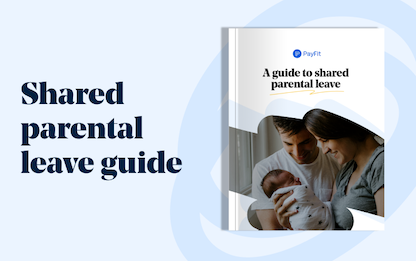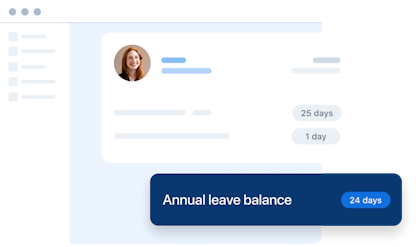- Blog
- |People management
- >Annual leave and absences
- >A guide to paternity leave
A Guide to Paternity Leave for Employers


Having a baby is life-changing for any parent, and that’s why statutory paternity leave is so important. Paternity leave allows partners and fathers time to bond with their newborn or adoptive child and support their partner during the first few weeks or months of their life with them.
As an employer, you must understand your responsibilities around paternity leave so you can confidently educate fathers, spouses, and partners working in your organisation about what they’re entitled to.
This guide explores what paternity leave is, who is entitled to it, how much paternity pay employees receive and tips on ensuring a smooth transition post-paternity leave.
What is paternity leave?
Paternity leave is leave, in addition to annual leave, that fathers, spouses, or partners can take to support their partner whether they’ve had a baby, adopted a child, or are having a baby through surrogacy. /
The leave is usually either one or two weeks long. If the employee chooses to take two weeks, these weeks must be taken consecutively and can be taken with the partner’s maternity leave or separately.
Employees can take paternity leave as soon as the baby has been born, but leave must be taken 56 days after the birth or adoption.
Some workplaces offer more than two weeks of paternity leave. If you offer anything different to this, you can outline it in your employment contract alongside other employee benefits.
You’re not legally required to offer additional paternity leave or anything on top of statutory paternity pay.
Who is eligible for paternity leave?
If your employee meets the following criteria they could be eligible to take paid paternity leave.
They must:
be employed by you up to the date of the birth (minimum 26 weeks’ continuous service)
earn at least £123 a week (before tax)
be the father of the baby to be born, be married to the mother or in a civil partnership, or be the intended parent (e.g. surrogacy)
The employee must give you sufficient notice to be eligible for paternity leave. They must tell you no later than 15 weeks before the expected due date.
If the person asking for paternity leave is an agency or contract worker, chances are they’re not eligible to receive paid paternity leave.
How much is statutory paternity pay?
Statutory paternity pay is currently £156.66 a week or 90% of their average weekly earnings (whichever is lower) per week. As an employer, you must still deduct tax and National Insurance from paternity pay.
You might decide to pay more than the statutory paternity pay, but this is at your discretion and not a legal requirement.
Can I refuse statutory paternity pay?
If an employee has given you the correct amount of notice for paternity leave and paternity pay and is eligible to receive it, you cannot refuse to pay it.
Paternity leave for adoption
An employee adopting a child must have been continuously employed by you for at least 26 weeks up to the ‘matching week’ — which is either the day they were matched with the child or the date the child entered the UK if the adoption is overseas.
As an employer, you can ask for proof of adoption from your employee in order to qualify for paternity pay. This proof can be an adoption agency letter or a matching certificate.
Employees must give you 28 days’ notice if they want to change their paternity leave start date.
Paternity leave for surrogacy
You are entitled to parental leave if you’re the intended parent to a child through surrogacy. Only one parent can apply to be the intended parent, which enables them to take 52 weeks off work and receive statutory maternity pay (SMP), but the other parent can apply for paternity leave if they’re eligible.
The couple can also explore the option of shared parental leave instead, if that better suits their situation.
Shared Parental Leave (SPL)
If employees are eligible, they can take advantage of Shared Parental Leave (SPL). SPL allows parents to share up to 50 weeks of leave and 37 weeks of pay between them following the birth or adoption of a child.
This setup gives both parents greater flexibility when it comes to caring for their child — adopting a better work-life balance for their family.
Your employee can take their shared leave together with the other parent or it can be taken consecutively. As an employer, you cannot unreasonably refuse a request for SPL.
Giving notice for SPL
When the parent wants to take shared parental leave, they must give your organisation eight weeks' notice each time. Please note, if the birth parent isn’t eligible for maternity leave, they will not be eligible for shared parental leave.
If an employee has applied for shared parental leave, you can ask for more details, such as a copy of the birth certificate and the name and address of your partner’s employer. If the employee is adopting a child, you can ask for the details of the adoption agency and the date the child will move into its new address.
Employees have 14 days to supply you with this information.
Statutory shared parental pay
Employees are also entitled to statutory shared parental pay (ShPP) during SPL, ShPP is currently £156.66 a week or 90% of your average weekly earnings, whichever is lower.
This is the same as Statutory Maternity Pay (SMP) but during the first six weeks, SMP is paid at 90% of whatever you earn (with no maximum).
Ensuring a smooth transition back to work
The thought of being away from work, whether it's a few weeks or months, can be equally exciting and daunting for an employee. If they’ve taken shared parental leave they could be out of the office for months, so you've probably had to find a temporary replacement.
Not only might the employee be worried about being replaced permanently, but being out of the office for so long comes with other challenges, from feeling left behind on work projects and not being part of the team dynamic to staff turnover and general changes during this time.
With all that in mind here are seven ways you can support employees returning from paternity leave.
Offer flexible work arrangements
Employees want employers that are flexible, particularly since the pandemic. And most of us want to prioritise our family life over work.
By supporting flexible work arrangements (flexible hours or the opportunity to work from home), you'll not only appeal to all the current parents working for your organisation, you become known for supporting a realistic work-life balance, helping you attract top talent into the future.
Provide a clear understanding of expectations on their return
Going back to a job you haven't done for a long time is scary. So take time to set expectations for their return, what does their first week back look like? What are you expecting them to do?
Clearly outlining this will alleviate any worries the parent had about returning to work after time away.
Allow time for catching up and training
Depending how long they've been on paternity leave, they might have missed new software being installed or the implementation of new team structures. How many times have you come back from a week-long holiday and forgotten your passwords? It's like that but 10 times worse.
Give them time to get their bearings and offer refresher training to get them back up to speed.
Offer support and resources for balancing work and family responsibilities
If they're finding everything overwhelming, make sure they have access to support and resources to help them navigate work life again. Support might look like regular one-to-one meetings or getting them a new laptop to help make home working a breeze.
Remember, if their wellbeing is suffering, their work might, too. So it's in your best interest to support your employees as best you can.
Encourage open communication with managers
You should ensure your employee feels comfortable enough to broach important topics with their line manager. Make sure the line manager is well equipped to deal with their return.
Sit with the manager to talk through expectations for the employee's return so you can confidently communicate this to them — this way, everyone is on the same page.
Provide opportunities for professional development
Offering opportunities for professional development helps employees feel valued because you're investing in upskilling their knowledge. This can help your employee returning from paternity leave reintegrate into the workplace, and, let’s be honest, everyone stands to benefit from professional development (including the organisation).
Promote a positive and inclusive work culture that values parenthood
You want your organisation to become known for having a supportive work culture. 92.6% of fathers with dependents are in the workplace, so making sure that family life is at the centre of your culture means you’re valuing what they value.
How PayFit can help employers manage paternity leave and pay
PayFit helps you automatically calculate accurate paternity pay. Simply input the date the employee will start their paternity leave and our payroll software will automatically calculate the statutory pay.
Our software also allows you to set up an Occupational Paternity Policy (OPP) where you can pay more than the legal minimum requirement for statutory paternity pay. For example, this means you can choose to pay an employee’s full salary for a period of time, dropping to 50% pay after this initial stint — whatever you decide to offer, you can include it here.
You can also edit the parameters of paternity pay in your policy with PayFit. This means you can customise your policy to outline how long employees have to have worked with you to be eligible, what they’ll be paid, and how it looks on their payslip.
Being able to customise this policy means next time someone goes on paternity leave, it’s already set up and ready to go. Minimum effort required!
To sum up
Paternity leave gives fathers and partners the chance to bond with their newborn baby or adopted child. For its many benefits, it might be surprising to learn that only a third of UK dads take paternity leave. The reason? The statutory pay rate isn’t worth it.
To encourage a better work-life balance for partners in your organisation, you could consider paying more than the legal minimum if you’re in a position to do so.
Learn more about how PayFit can help you breeze through statutory and occupational paternity pay calculations. Book a demo with a member of the team today.


UK Expenses Management - A Guide For Employers

Overtime Pay Rates & Laws in the UK

The 2024 UK National Living Wage - An Employer’s Guide

The Cost Of Recruitment In The UK - What You Might Not Know

UK National Insurance Changes for January 2024


